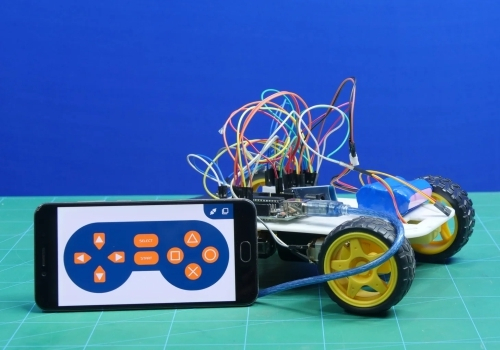Remote-controlled robot
School Level
Packages comprises of
- Recorded Lectures
- Study Material - Pdf
- Edp
- Assessment followed by certificate after completion of 50 %
- Prototype Project view of minimum duration
- Mentorship
- Submission of Project
- Certificate after successful completion of project work
Overview
A remote-controlled robot is a machine that is controlled by a human operator from a distance using a wireless transmitter and receiver system. The robot can be designed to perform a wide range of functions, such as moving, grabbing and manipulating objects, exploring hazardous or remote environments, and even performing surgical procedures. Remote-controlled robots are commonly used in industrial settings, military applications, and scientific research, and they are increasingly becoming popular for entertainment and hobbyist purposes as well. They are typically powered by batteries or electricity and can be controlled using a variety of input devices, such as joysticks, remote controls, and computer interfaces.
Remote-controlled robots are typically made up of a number of different components, including a power source, a control system, sensors, and actuators. The power source provides the energy needed to drive the robot's motors and other mechanisms, and can be either battery-powered or connected to an external power source. The control system is responsible for interpreting the commands sent by the operator and translating them into actions performed by the robot.
Sensors are an important component of remote-controlled robots, as they allow the machine to perceive its environment and respond appropriately to changes. Common sensors used in remote-controlled robots include cameras, microphones, and various types of proximity sensors, such as sonar or laser sensors.
Actuators are the mechanical components that allow the robot to perform physical actions, such as moving its arms, legs, or other appendages. Common actuators used in remote-controlled robots include motors, hydraulic or pneumatic systems, and solenoids.
Remote-controlled robots are used in a wide range of applications, including industrial settings, military operations, scientific research, and even entertainment and hobbyist pursuits. In industrial settings, remote-controlled robots are often used for tasks that are too dangerous or difficult for humans to perform, such as inspecting pipelines or performing maintenance tasks in hazardous environments. In the military, remote-controlled robots are used for bomb disposal, reconnaissance, and other tasks that would otherwise be too dangerous for human soldiers.
In scientific research, remote-controlled robots are used for a variety of purposes, including exploring remote or inaccessible environments, such as the deep sea or outer space, as well as for conducting experiments or collecting data in hazardous or dangerous environments, such as nuclear power plants.
Finally, remote-controlled robots are also popular for entertainment and hobbyist pursuits, such as building and controlling remote-controlled cars, planes, or drones. In these applications, the focus is often on creating a fun and engaging experience for the operator, rather than on accomplishing specific tasks or objectives.
In summary, remote-controlled robots are versatile machines that can be used for a wide range of purposes, from industrial and military applications to scientific research and entertainment pursuits. They rely on a combination of power sources, control systems, sensors, and actuators to perform their functions, and can be customized to suit the needs of different applications and operators.
Please rotate your device
We don't support landscape mode yet. Please go back to Portrait mode for the best experience.






